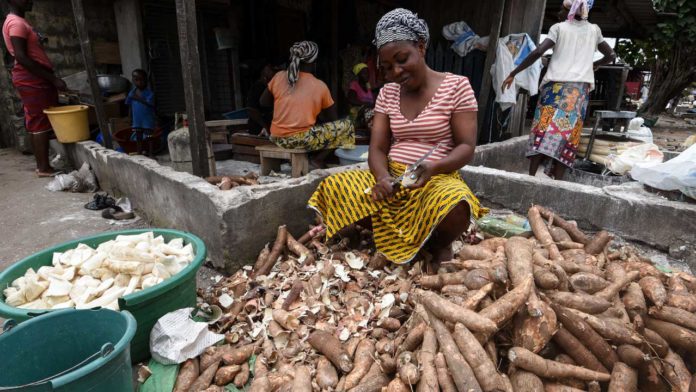ABIDJAN, July 8, 2018 (BSS/AFP) – Researchers from half a dozen states in
West Africa have joined together in a battle against what one expert calls a
root crop “Ebola” — a viral disease that could wreck the region’s staple
food and condemn millions to hunger.
Their enemy: cassava brown streak disease (CBSD), a virus that strikes
cassava, also called manioc, which in some of the region’s countries is
consumed by as many as 80 percent of the population.
The root-rotting disease was first discovered in Tanzania eight decades
ago and is steadily moving westward.
“In outbreaks in central Africa, it has wiped out between 90 and 100
percent of cassava production — it’s now heading towards West Africa,”
Justin Pita, in charge of the research programme, told AFP.
“It is a very big threat. It has to be taken very seriously.”
In Uganda, 3,000 people died of hunger in the 1990s after the dreaded
disease showed up, striking small farmers in particular.
“You can call it the Ebola of cassava,” said Pita.
The West African Virus Epidemiology (WAVE) project, a multi-million-dollar
scheme funded by the Bill and Melinda Gates Foundation, aims to shield the
region from the advancing peril.
Headquartered at Bingerville, on the edges of the Ivorian economic capital
Abidjan, it gathers six countries from West Africa — Benin, Burkina Faso,
Ghana, Ivory Coast, Nigeria and Togo — as well as the Democratic Republic of
Congo.
Much is already known about CBSD — the virus is generally believed to be
propagated by an insect called the silverleaf whitefly, and also through
cuttings taken from infected plants.
But there remain gaps in knowledge about West Africa’s specific
vulnerabilities to the disease.
They include understanding the susceptibility of local strains of cassava
to the virus, and identifying points in the cassava trade that can help a
localised outbreak of CBSD swell into an epidemic.
The scheme will also look at initiatives to help boost yield — a key
challenge in a region with surging population growth.
“The current average yield from cassava (in West Africa) is 10 to 12
tonnes per hectare (four to 4.8 tonnes per acre), but it has the potential to
reach 40 tonnes a hectare,” said Odile Attanasso, Benin’s minister of higher
education and scientific research.
“In Asia, they have yields of 22 tonnes per hectare.”
– ‘Attieke is our husband’ – The WAVE project hopes to go beyond the lab
and test fields, though.
It also wants to harness the clout of community leaders and chiefs to
spread CBSD awareness and promote better farming practices, such as confining
and destroying crops in infested areas and banning transport of manioc
cuttings.
“We kings and traditional chiefs are the interface between the population
and the government,” said Amon Tanoe, the ceremonial monarch of the coastal
Grand-Bassam region in Ivory Coast.
Ivory Coast is a huge consumer of cassava — the starchy root is typically
pulped and fermented and served in a side dish called attieke.
In Affery, a big cassava-growing region about 100 kilometres (60 miles)
east of the economic capital Abidjan, makers of attieke said they were deeply
worried about the threat of CBSD.
“Attieke is our husband,” said Nathalie Monet Apo, head of the association
of attieke producers, emphasising how the cassava dish is intertwined with
Ivorian life.
“If the disease shows up, it would be dramatic for our families and our
community.”
“They have to find a cure for this disease — it’s thanks to growing
cassava that I am able to provide an education for my four children,” said
Blandine Yapo Sopi, eyeing a mound of harvested manioc that she hoped would
bring in 450,000 CFA francs (nearly 700 euros, around $800).



